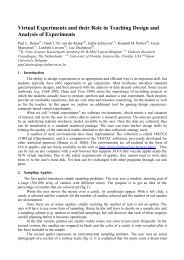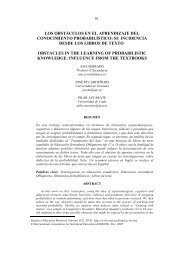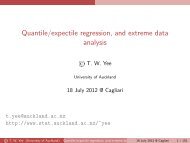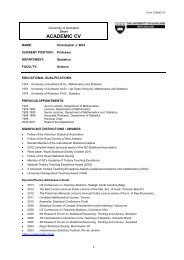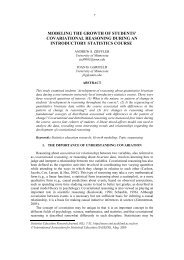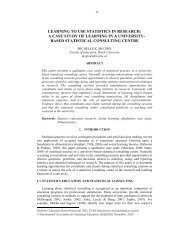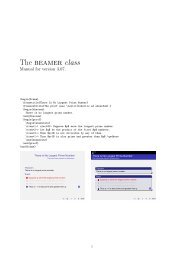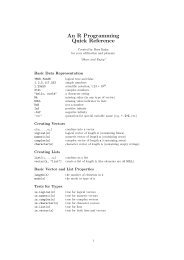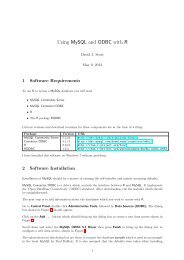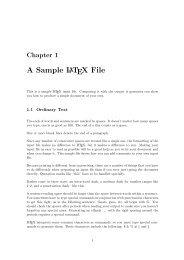PERMDISP - Department of Statistics
PERMDISP - Department of Statistics
PERMDISP - Department of Statistics
You also want an ePaper? Increase the reach of your titles
YUMPU automatically turns print PDFs into web optimized ePapers that Google loves.
5<br />
use transformations to “fix” the problem <strong>of</strong> heterogeneity when dealing with univariate data sets. Be aware<br />
that when you transform data (using square roots, fourth roots, logs, etc.) you are also affecting the relative<br />
spread <strong>of</strong> the observations.<br />
Note 4: Your choice <strong>of</strong> distance or dissimilarity measure will radically affect your results. Many<br />
dissimilarity measure have intrinsic row (observation) standardizations in them, such as Bray-Curtis, Chisquared,<br />
CY dissimilarity, etc. As such, these change the relative dispersions within groups, especially for<br />
observations that have species with large abundances. Distance measures such as Euclidean, Manhattan and<br />
Gower’s measure do not have such intrinsic row standardizations.<br />
III. Running the Program<br />
A. Parameters <strong>of</strong> the Program<br />
The parameters <strong>of</strong> <strong>PERMDISP</strong> are currently set as follows:<br />
maximum no. <strong>of</strong> levels <strong>of</strong> either factor (a or b) = 20<br />
maximum sample size (no. <strong>of</strong> replicates, n) = 50<br />
maximum no. <strong>of</strong> variables = 500<br />
maximum total no. <strong>of</strong> observations or samples (N = a x b x n) = 500<br />
If the program will not run on your machine, it could be that the parameter settings are too large for your<br />
computer’s memory, or your data matrix or design exceeds the parameter settings.<br />
B. Format and Structure <strong>of</strong> the Input Data File<br />
One can either input a file containing raw data, or input a file containing a symmetric matrix <strong>of</strong> distances or<br />
dissimilarities. In each case, the file must be saved in tab delimited (ASCII text, *.txt) or comma delimited<br />
(*.csv) format. If you are using a Macintosh, then save the file (for example, from Excel) as “Text<br />
(Windows)”. If you save it as a simple text file from Excel, it won’t run unless you open up the file again<br />
(for example, using a text editor such as BBEdit) and manually add a carriage return (“Enter”) to the end <strong>of</strong><br />
the last line. This is a weird quirk <strong>of</strong> the way the Mac version <strong>of</strong> Excel saves text files that, for some reason<br />
unknown to me, causes my program to crash. You should not experience any such problem, however, if the<br />
file is saved as “Text (Windows)” or if the file was created using a different text editor.<br />
The option <strong>of</strong> entering a symmetric distance matrix means that the user can base the analysis on any<br />
distance measure <strong>of</strong> choice. If none <strong>of</strong> the choices <strong>of</strong> distance measures <strong>of</strong>fered in the <strong>PERMDISP</strong> program<br />
are suitable, then one can use a different distance function in another program and input this distance or<br />
dissimilarity matrix directly.<br />
A file containing raw data can be organised in one <strong>of</strong> two ways. Either (i) observations are in rows and<br />
variables (species) are in columns or (ii) variables are in rows and observations are in columns. The<br />
organisation <strong>of</strong> the samples should follow the experimental design, with the first partitioning <strong>of</strong> the data<br />
according to factor 1, the second partitioning according to factor 2, etc. For example, let’s say the data are<br />
organised so that columns are variables and rows are samples. In the case <strong>of</strong> two species variables in a 2factor<br />
crossed (orthogonal) experimental design, where each factor has 2 levels and the sample size is n =<br />
3, one would have two columns <strong>of</strong> numbers (corresponding to the two species) with the following<br />
organisation:



